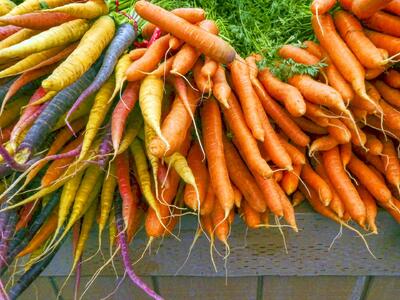Carrots actually come in a variety of colors beyond the standard orange. Some of the colors can be hard to find, but it's worth seeking them out. Here's a quick rundown of the various colors:
- White carrots: Probably the least nutrient dense carrot, white carrots still have valuable phytochemnicals. They have a very mild, some say boring, taste.
- Golden carrots: These contain lutein, which is sort of a sunblock for the eyes. They have a sweet mellow flavor, with a hint of earthiness.
- Orange carrots: Rich in beta carotene which converts to Vitamin A in the body. Very sweet and juicy, with a higher sugar content.
- Purple carrots: Along with beta carotene, these are high in the antioxidant anthocyanin. They have a very earthy and sometimes slightly spicy flavor.
The best carrots are the ones you grow yourself, but not everyone has the time or space to grow them. Plus it would take a lot of space to grow enough carrots for regular juicing. Otherwise, try for organic carrots if possible. This way you can be assured that they are pesticide-free which gives you the option to juice the nutrient-rich greens as well.
In non-organic stores, avoid carrots with the greens still on. They may look attractive, but they aren't optimal for juicing because the capillary action of the carrot continues transferring water from the root to the leaves even after it has been picked, resulting in a softer and less juicy carrot. They are also expensive for what you get, and tend to be slimmer.
Look for the firmest possible carrots possible. Check the top of the carrot, and look for a green top instead of brown or black. If possible, flex the lower portion of the carrot. The firmer, the better. Thicker carrots are preferred, even if it means more preparation, because the juice of the carrot is concentrated in the core. A thicker carrot will have a higher ratio of juice to pulp, with a higher juice yield per kilogram. The juice will aslo be sweeter, as the natural sugars are more concentrated in the core.







